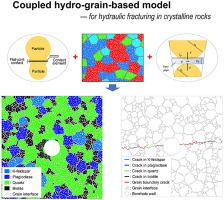International Journal of Rock Mechanics and Mining Sciences ( IF 7.0 ) Pub Date : 2021-06-16 , DOI: 10.1016/j.ijrmms.2021.104766 Lie Kong , Pathegama Gamage Ranjith , Bing Qiuyi Li

|
The grain-scale heterogeneity of rock has been found to greatly affect the cracking behaviour in mechanical tests. However, the heterogeneity has been insufficiently considered in hydraulic fracturing. To fill the gap, this paper proposes a coupled hydro-grain-based discrete element model and explores the fluid-driven micro-cracking of crystalline rock. The micro-heterogeneity of the rock is represented by a grain-based model. Three laboratory-scale fracturing cases over granite under different in-situ stresses are simulated. First, typical micro behaviour and hydro/hydro-mechanical responses are presented and interpreted. Next, sensitivity analysis of in-situ stress conditions is carried out. It is found that hydraulic fracturing of crystalline rock involves many unique behaviours on grain-scale such as non-symmetrical propagation, “zipper mode” initiation time order, generations of isolated and branching cracks, and re-closure of the cracks earlier initiated. Cracks can be induced in mineral grains and along the grain interfaces. The cracking mode is dominated by tension failure, with a small proportion in shear (between 3.5% and 1.5%). The interplays among orientation, aperture and number of different types of crack show that: 1. The inclination of cracks to the direction of maximum confining stress may occupy the entire range from 0° to 180°; 2. The aperture of cracks decreases statistically with their orientations turning to the direction of the minimum confining stress (σ3); 3. Increases in σ3 suppress the generation of total cracks and tend to force cracks to propagate in mineral grains; 4. A small in-situ stress difference results in fewer branching and isolated cracks. In this paper, evolutions of injection pressure and rock deformation during hydraulic fracturing are also discussed.
中文翻译:

流体驱动的结晶岩微裂纹行为采用基于水力颗粒的耦合离散元方法
已发现岩石的颗粒尺度非均质性极大地影响了力学试验中的开裂行为。然而,水力压裂对非均质性的考虑不够充分。为了填补这一空白,本文提出了一种基于水力颗粒的耦合离散元模型,并探讨了结晶岩的流体驱动微裂纹. 岩石的微观非均质性由基于颗粒的模型表示。模拟了在不同地应力下花岗岩上的三个实验室规模的压裂案例。首先,呈现和解释了典型的微观行为和水力/水力机械响应。接下来,进行地应力条件的敏感性分析。研究发现,结晶岩的水力压裂在晶粒尺度上涉及许多独特的行为,例如非对称扩展、“拉链模式”起裂时间顺序、孤立和分支裂缝的产生以及较早开始的裂缝的重新闭合。裂纹可以在矿物颗粒中和沿颗粒界面诱发。开裂模式以拉伸破坏为主,剪切破坏比例较小(3.5%~1.5%)。这不同类型裂纹的取向、孔径和数量之间的相互作用表明: 1. 裂纹向最大围应力方向的倾角可能占据0°~180°的整个范围。2. 裂纹的孔径随着其方向转向最小围压( σ 3)方向而在统计上减小;3. σ 3 的增加抑制了总裂纹的产生并趋于迫使裂纹在矿物颗粒中扩展;4. 较小的原位应力差异导致较少的分支和孤立裂纹。本文还讨论了水力压裂过程中注入压力和岩石变形的演变。











































 京公网安备 11010802027423号
京公网安备 11010802027423号